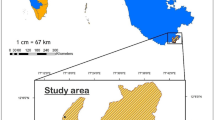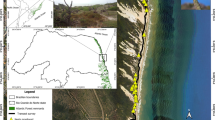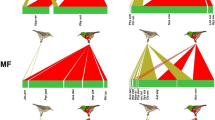Summary
Foraging by a social wren, Campylorhynchus nuchalis (Troglodytidae), in a tropical savanna habitat is not enhanced by aggregation. Data for marked individuals show that solitary foraging results in a higher capture rate than foraging near others. We find no evidence of imitative foraging, as individuals actively avoid successful foragers following a capture and successful foragers do not restrict their search to recently productive stations or techniques. Captures are seldom temporally clumped, and clumping is probably not pronounced enough to favor imitation. Juveniles show no greater tendency to respond to captures of others, or to succeed in foraging in a group, than do adults. Aggregation is probably disadvantageous for foraging because of dispersed, scarce, cryptic, and noneruptive prey and because of the searching technique of these foliage-gleaning insectivores. If predator avoidance is enhanced by aggregation, it does not result in either increased survival or increased foraging efficiency in large groups, even by juveniles.
Similar content being viewed by others
References
Altman, J.: Observation study of behavior—sampling methods. Behaviour 49, 227–267 (1974)
Andersson, W., Wiklund, C.G.: Clumping versus spacing out: Experiments on nest predation in fieldfares (Turdus pilaris). Anim. Behav. 26, 1207–1212 (1978)
Berram, B.C.R.: Living in groups: Predators and prey. In: Behavioural ecology. Krebs, J.R., Davies, N.B. (eds.), pp. 64–96. Sunderland. MA: Sinauer 1978
Brown, J.L.: Avian communal breeding systems. Annu. Rev. Ecol. Syst. 9, 123–156 (1978)
Crook, J.H.: The evolution of social organization and visual communication in the weaverbirds (Plociedae). Behaviour [Suppl.] 10, 1–178 (1964)
Eisenberg, J.F., Muckenhirn, N.A., Rudran, R.: The relation between ecology and social structure in primates. Science 176, 868–873 (1972)
Emlen, S.T.: Cooperative breeding. In: Behavioural ecology. Krebs, J.R., Davies, N.B. (eds.), pp. 245–281. Sunderland, MA: Sinauer 1978
Gaston, A.J.: The evolution of group terriorial behavior and cooperative breeding. Am. Nat. 112, 1091–1100 (1978)
Goss-Custard, J.D.: Variation in the dispersion of redshank Tringa totanus on their winter feeding grounds. Ibis 118, 257–263 (1976)
Kenward, R.E.: Hawks and doves: Attack success and selection in goshawk flights at wood-pigeons. J. Anim. Ecol. 47, 449–460 (1978)
Krebs, J.R.: Social learing and the significance of mixed-species flocks of chickadees (Parus spp.). Can. J. Zool. 51, 1275–1288 (1973)
Krebs, J.R.: Colonial nesting and social feeding as strategies for exploiting food resources in the Great Blue Heron (Ardea herodias). Behaviour 51, 99–134 (1974)
Krebs, J.R.: MacRoberts, M.H., Cullen, J.M.: Flocking and feeding in the Great Tit: An experimental study. Ibis 114, 507–530 (1972)
Lack, D.: Ecological adaptations for breeding in birds. London: Methuen 1968
Powell, G.V.N.: Experimental analysis of the social value of flocking by starling (Sturnus vulgaris) in relation to predation and foraging. Anim. Behav. 22, 501–505 (1974)
Ricklefs, R.E.: The evolution of co-operative breeding in birds. Ibis 117, 531–534 (1975)
Sabine, W.S.: Dominance in winter flocks of juncos and tree sparrows. Physiol. Zool. 22, 64–85 (1949)
Siegel, S.: Nonparametric statistics for the behavioral sciences. New York: McGraw-Hill 1956
Siegfried, W.R., Underhill, L.G.: Flocking as an antipredator strategy in doves. Anim. Behav. 23, 504–508 (1975)
Smith, P.C., Evans, P.R.: Studies of shorebirds at Lindisfarne, Northumberland. I. Feeding ecology of the bar-tailed godwit. Wildfowl 24, 135–139 (1973)
Sokal, R.R., Rohlf, F.J.: Biometry. San Francisco: Freeman 1969
Turner, E.R.: Social feeding in birds. Behaviour 24, 1–46 (1965)
Waser, P., Wiley, R.H.: Mechanisms and evolution of spacing behavior. In Handbook of behavioral biology: Social behavior and communication. Marler, P., Vandenberg, J. (eds.) New York: Plenum (1979) (in press)
Wiley, R.H.: Social groups in tropical wrens. American Philosophical Society, Year Book 1977 (1979) (in press)
Wiley, R.H., Wiley, M.S.: Recognition of neighbor's duets by stripe-backed wrens Campylorhynchus nuchalis. Behavior 62, 10–34 (1977)
Author information
Authors and Affiliations
Rights and permissions
About this article
Cite this article
Rabenold, K.N., Christensen, C.R. Effects of aggregation on feeding and survival in a communal wren. Behav Ecol Sociobiol 6, 39–44 (1979). https://doi.org/10.1007/BF00293243
Received:
Accepted:
Issue Date:
DOI: https://doi.org/10.1007/BF00293243




